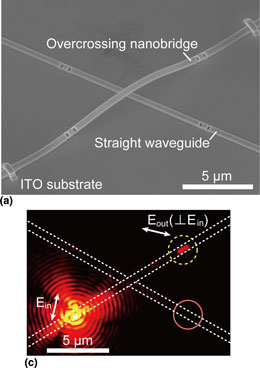Article contents
Surface plasmon propagation on overcrossing metallic waveguides fabricated by a pick-and-place method
Published online by Cambridge University Press: 23 December 2015
Abstract

Plasmonic waveguides can transport light while still confining it beyond the diffraction limit. Recently, crossing plasmonic waveguides have been suggested for the implementation of higher-density optical networks. However, suppressing undesirable scattering at their crossing point is still a challenging task because waveguides in these structures are physically connected. Here, we present an experimental demonstration of surface plasmon propagation on an overcrossing metallic waveguide fabricated by a pick-and-place method. By spatially separating the waveguides, the undesirable interaction at the interconnection can be suppressed. Our approach could be a powerful platform to achieve high-density integration of optical waveguides.
- Type
- Plasmonics, Photonics, and Metamaterials Research Letters
- Information
- Copyright
- Copyright © Materials Research Society 2015
References
- 2
- Cited by


